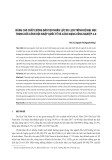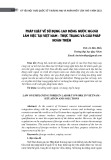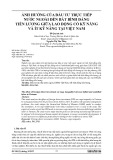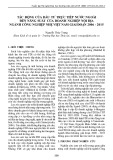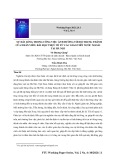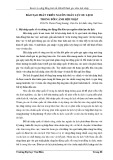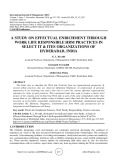
VNU Journal of Science: Economics and Business, Vol. 36, No. 2 (2020) 1-12
1
Original Article
A Review of Literature on Immigration
in Developed Countries:
Determinants of Employment Discrimination
Ho Hoang Lan*, Doan Danh Nam
National Economics University, 207 Giai Phong Road, Hanoi, Vietnam
Received 05 November 2019
Revised 07 January 2020; Accepted 07 January 2020
Abstract: Despite having endorsed civil rights and equality of all individuals, society nowadays
remains segregated in many aspects. Apparently, those with unfamiliar styles (culture,
communication, religion, etc.) have always been the centre of this malaise, which is getting even
more serious with the recent immigrant crisis in Europe. Hence, the goal of this literature review is
to gain an understanding of research into the causes of prejudice and discrimination so far.
Specified in this paper are the reasons why such employment discrimination still exists, which may
come down to one or more of five major factors: Ethnicity and Religion, Culture Norms and
Values, Educational Level, Historical and Contemporary Issues and Organizational Environment.
None alone would be solely sufficient to explain the causes; hence, this paper will attempt to
connect them into one integrated model. Ethically, this paper pointed out not only the roots but
also the solutions to them. Though, it is a complex issue, requiring a systematic solution, societal
awareness and action. However, the paper has given details of potential future directions from
household to national level that may simplify the complexity of the solutions.
Keywords: Immigrants, employment discrimination, prejudice, ethnic conflict, foreign-born worker.*
_______
*Corresponding author.
E-mail address: ho.lan@isneu.org
https://doi.org/10.25073/2588-1108/vnueab.4300

H.H. Lan, D.D. Nam / VNU Journal of Science: Economics and Business, Vol. 36, No. 2 (2020) 1-12
2
1. Introduction
Alongside with the globalization, international
migration poses various prominent, ethical and
controversial issues related to discrimination
against the migrants in the workplace. Direct
discrimination is referred to as less favourable
treatment due to race or sex, whereas indirect
discrimination is less obvious, characterised by
harsher employment requirements for one racial or
sexual group [1].
1.1. Discrimination in Developed Economies
There are two ways of immigrant movements -
i) those moving from developing countries to more
advanced economies, and ii) first-world workers
seeking job opportunities in other areas of the
world. This paper will solely cover insights into
the first one (where the rule of equilibrium dictates
that the first trend tends to occur, lowering salaries
to offset the abundance of immigrants) [1].
A summary of the immigrant employment
situation in five developed countries follows.
United States - Highlights from foreign-born
workers report show that immigrants are less likely
to be hired in management and professional
positions, with a median of usual weekly earnings
of $730 compared to $885 for native personnel
(direct discrimination). The jobless rate also varies
significantly among racial groups (Black - 5.6%,
Hispanics - 4.3% and Asians - 3.2%) [2].
Austria - A study focuses on Muslim
immigrants, who are considered at the root of the
increasing malaise. Discrimination is linked to pay
rates, workload, appreciation and working
conditions by approximately a quarter of
immigrants. 35% of the immigrants are threatened
with sacking for having sick leave or refusing to
work overtime [3].
Spain - Agudelo-Suárez et al. (2009)
conducted qualitative research on how the
immigrants feel. In specific circumstances,
interviewees specified discrimination and rejection
as xenophobia and racism. Other feel vulnerable
and powerless. On the other hand, the Spanish-
born population feels immigrants are taking over
their jobs and other social, cultural, economic and
educational space [4].
Canada - The immigrants has struggled as their
unemployment rate is twice as high and wages are
35% lower than non-immigrants. The inequality
persisted even when immigration policies have been
enacted to rate applicants based on their educational
degrees, language, or occupations “in demand” [5].
1.2. Discrimination as an Expression of Prejudice
Modern studies of Prejudice and
Discrimination are studies of conflict [6, 7].
Prejudice is a negative evaluation of an individual
based on his/her group membership, whereas,
Discrimination is negative behaviours and
actions [8].
In the past, Allport (1954) required prejudice
to be “unfounded” and “irrational”, affective and
primary with lingered emotion and defeated
secondary intellect. Allport’s Compunction
galvanized most of the historical theories of racial
prejudices, which all treat “rational” and
“irrational” expressions identically [9].
These social psychology theories remained
until Crandall & Eshleman (2003) characterized
the prejudices into a Two-Factor Model. The first
is genuine prejudice, referring to “irrational”
prejudice - primal, powerful, automatic, and
cognitively simple. It is based on the historical
issue (Apartheid) when most Whites have genuine
or unadulterated prejudice against Blacks [8]. The
other factor refers to the motivation to control the
first (creating “American Dilemma” [10]. Myrdal
saw the reality where White Americans did not
wish to openly express prejudice verbally in order
to maintain a self-image of non-prejudice, of being
liberal, politically correct, egalitarian and
humanitarian.
Figure 1. Crandall & Eshleman Justification-
Suppression of Prejudice Model.
Source: Crandall & Eshleman (2003).
In Justification-Suppression of Prejudice
model (JSM), the mental processes that lead to
genuine prejudice will create negative behaviours
(discrimination). Crandall and Eshleman reduced
all the reviewed perspectives to one structure - the
Two-Factor theory of Prejudice:
Prejudice + Suppression = Expression
They argued that prejudice itself is not usually
and easily expressed but it must go through a

H.H. Lan, D.D. Nam / VNU Journal of Science: Economics and Business, Vol. 36, No. 2 (2020) 1-12
3
mental process that modifies and evaluates
(Justification and Suppression) before being
expressed manipulatively to meet social norms and
personal goals. The end results are: i) public
expression of prejudice (include derogation,
discrimination, etc.) and ii) experienced prejudice
(include private acceptance of negative
evaluations) [8]. However, Crandall & Eshleman’s
paper assumed that everyone has some prejudices
and stopped at only assessing factors that enhance
or minimize the expression of prejudices.
More recent, Rogers & Prentice-Dunn (1981)
updated the two-factor theory with “regressive
racism” - genuine prejudice is masked by norms
for appropriate egalitarian values, but the Whites
population may still revert to the old pattern of
discrimination when emotionally aroused, angered
or insulted [11].
The main findings will address two groups of
factors that contribute to employment
discrimination against immigrants, as well as their
impacts and the moderators that facilitate or
suppress the impacts, these being i) “Psychological
factors” and ii) “Social and Political Factors”.
Finally, this paper will attempt to introduce an
integrated model to form an overview of different
perspectives from mentioned researches..
2. Determinants of Discrimination
Different authors have vastly different ideas on
which basis one group can be discriminated. There
can be one or a collection of several reasons,
including group identity [12], stigma [13],
prejudice or ascribed characteristics [14], or social
category [15].
Besides, employment discrimination against
immigrants is not a blatantly obvious phenomenon
and is rather contingent on other factors (multiple
moderators and contextual factors that determine if
an effect is strong or weak) and there will hardly
exists one main effect on attitudes to, and work
outcomes for, immigrants.
2.1. Psychological Factors
The psychological aspect, though simple and
consisting of only a few factors (mostly referred to
prejudice as primal and irrational), remains a big
part of previous research studies. Most focused on
traditional social psychology - depicting the issue
as a manifestation of prejudices and stereotypes
(relating to ethnicity) [16].
Following is the categorization of different
types of racism (modern or symbolic, ambivalent,
and aversive) in the 1970s-1980s and dissociated
cultural and personal stereotypes in the 1990s [6].
- Religion and ethnicity
Immigrants are commonly defined as foreign-
born, but move to other countries and earn the
right to reside long-term with or without
citizenship [17]. However, the term Immigrants
may have gone beyond its literal meaning
(referring to nationality) into culture, sociology
and psychology. Ethnicity concerns even a bigger
population if we include second and later
generations. Immigrants in the US are seen as
foreign not only due to their looks, but also their
distinctive communication style, restricted social
circle, and different norms and values (“Perceived
Foreignness”) [18].
Figure 2. A model of the glass ceiling for
the foreign born.
Source: Chen et al. (2013).
The sociocultural approach often considers
prejudices as a result of an historically determined
process [19]. In the US, there is prominent
evidence of racial stereotyping, which often is
negative characteristics that one group (e.g.,
Whites) associates distinctively with others
(Blacks or Asians or Hispanics) [20]. In Kinder &
Mendelberg's (1995) paper, about one half to
roughly a majority of 60% of Whites thought they
are more hard-working and intelligent; while
Blacks were associated with laziness, welfare-
dependence and low motivation [21]. Apparently,
this thinking had profound influences on whites’

H.H. Lan, D.D. Nam / VNU Journal of Science: Economics and Business, Vol. 36, No. 2 (2020) 1-12
4
opinions, eventually leading to opposition against
federal assistance to Blacks.
Whereas in Europe, Reitz & Verma (2004) as
well as Swidinsky & Swidinsky (2002) all pointed
out that in Western society, non-Caucasian
immigrants experience poorer treatment than
Caucasian immigrants [22, 23]. Meertens &
Pettigrew's (1997) paper of Western European’s
prejudice encompassed a range of ethnic groups
against whom there was subtle and blatant
prejudices. The paper mentioned the recent change
to “a more subtle form of out-group prejudice”
[24], which is similar to findings of new subtle
prejudice as “cool, distant, and indirect” [25].
Also, the movement away from prejudice may
arise from the individual level with highly
internalized egalitarian values [6]. However,
Devine (1989) argued that prejudice expression is
a result of both automatic and controlled
processes. Stereotyped beliefs can be immediately
and effortlessly activated in children’s memories
even before cognitive ability and ability to
question their (stereotyped beliefs) validity or
acceptability are developed [26].
At an individual level, when it comes to
religiosity, most empirical research studies
commonly approached the issue in two ways. Early
on, between 1940 and 1990, the most dominant
approach was to merely evaluate the strength of the
relationship between religious involvement and the
level of prejudice. Following this approach, “The
more religious an individual is, the more
prejudiced he or she is likely to be” [27]. However,
such an approach failed to assess the differences
among religious beliefs. Thus, another approach is
based on distinctions between different dimensions
of religiosity. Illustrative examples of this
approach include, extrinsic and intrinsic religious
orientation. Extrinsically religious people are
linked with being more prejudiced than
intrinsically religious individuals [28]. Besides,
religious training itself may as well cause
prejudice. For example, the Bible may have
prescribed prejudice and discrimination against
“homosexuals, women, and members of other
religions” [29].
Prejudice against one religion can also lead to
generalised prejudice against one ethnicity. For
example, not only are Muslims discriminated
against as a result of such change, but also Middle
Eastern immigrants suffer the same prejudice.
Research traced back to 1999-2000 saw anti-Muslim
prejudice to be more widespread than for other
immigrants in both Western and Eastern Europe,
even before the attacks of September 11th [30]. Since
Islam is the dominant practice in the Middle East, it
caused the categorization process of group similarity
and formation of bias perceptions [31].
Contradictorily, perception of immigrants
might be independent from religious beliefs, and
rather due to political ideologies (conservatives
tend to be more negative than liberals) [32].
- Different cultural norms and values
In the past, authors have shown an openly
hostile expression towards immigrants and
negative stereotypes [33, 34]. Nowadays, even the
multi-cultural Americans are actively seeking to
mitigate the prejudices. Indeed, the White
Americans exhibited aversive racism, which is a
result of i) prejudice developed from historical and
culturally racist contexts, and ii) maintaining a
system of egalitarian values [35].
Genuine prejudice can also develop from
family contexts - either indirect (parental
discriminative behaviours can be learned by their)
[36] or direct (strictly prohibit or mildly limit
interracial) [37].
Alternatively, people in one society can learn
and share cultural norms from their
neighbourhoods as well as mass and social media.
Indeed, children may imitate prejudicial
behaviours from their peers [38, 39]. However,
there are suppressive factors to these differences in
cultural norms - where it deals mostly with human
maturity. As people grow up and the norms and
values of a societal group become negative toward
straightforward prejudice, people also become
more skilled as well as motivated to suppress
their prejudice.
Besides, recent authors have emphasized the
effects of negative news presented on TV [40]. An
instance was when Italy became a “new
immigration country” for Muslim immigrants.
However, controversies with Muslims’ position in
Italian society quickly emerged due to
controversial international issues that influenced
the domestic relations and attitudes [41].
- Educational level
Although impacts of the ethnicity and religion
of immigrants clearly exist, there are exceptions in
variety groups of immigrants, which may come
down to the differences in educational level
(among immigrants or among locals).
Differences in education levels among
immigrants can lead to further social and
economic issues:
Immigrants status does not necessarily imply
crime, yet the recent “crimmigration crisis” -

H.H. Lan, D.D. Nam / VNU Journal of Science: Economics and Business, Vol. 36, No. 2 (2020) 1-12
5
criminal immigrants [42] - caused authors to look
for determinants of this unexpected implication. It
is not until recently that the public finally
recognised the problem but the increasing
immigrants pouring into European countries only
emphasized the inevitable. There is a positive
correlation between the immigrant population size
and the overall crime rate in Italy during 1990-
2003 [43]. On a broader scale, disadvantaged
minority groups are “disproportionately likely to
be arrested, convicted, and imprisoned for violent,
property, and drug crime” (Blacks or Afro-
Caribbean in the US, or North African Arabs in
France) [44].
In some large economies in Europe, there was
evidence of second-generation immigrants
experiencing significantly higher education,
earnings, and employment [45]. Group threats is
the explanatory factor for the situation [6]. The
difference is, while lower education may drive
people into a fear of crime, higher-educated
immigrants may relatively take over jobs, welfare
benefits and other gains [46].
Besides, the educational level among locals
may also attribute to attitudes against immigrants:
In France, Germany, Spain and the US, higher
educational levels as well as actual direct contact
with the immigrant groups correlate with more
positive attitudes towards the members [32].
However, Midtbøen (2014) also argued that
negative experience with such groups of
immigrants can lead to prejudice against that social
group [47].
2.2. Social and Political Factors
Economists and sociologists have long been
studying immigration and immigrants as well.
Contextual studies of stereotypes, prejudice and
discrimination also started as early as hypotheses
proposed in the 1940s, and quickly evolved to an
analysis of contact and categorization (cognitive
approaches) in the social context [9] before
hinging towards intergroup contact driven by
social structure in the 1990s.
- Historical and contemporary issues
Once, apartheid was one of the most
controversial racial discrimination beliefs. Despite
remarkable efforts by modern society towards
promoting civil rights, some countries have
remained very much segregated, including the US
[21]. Before the American Dilemma, blacks had to
suffer prejudice as justification for the degradation
of slavery. Globalization has accelerated gradually
over 60 years with stunning impacts in
technological changes and international trade,
lowered language barriers, and transportation
costs. Globalization is implicitly recognized for
poverty reduction - supporting micro-enterprises,
raising income and employment opportunities,
attracting immigrants from developing countries
[48]. Increasing national wealth comes with social
changes to be more open to other groups and to
move away from ethnocentrism [49].
However, the outflows of workers to more
advanced and better-remunerated economies may
result in brain-drain for developing countries.
OECD countries estimate that 30% of migration is
linked to labour [50]. Besides the push factor (lack
of employment opportunities in advanced
industries and higher salary), there are also some
pull factors that contributed to workers’ movement
to first-world economies (settle and support
relatives to follow, or business investment [51].
The neglect of international employment raises
severe problems [52]. Besides the taking of jobs,
and scrounging welfare benefits from citizens’
taxes, Europe is currently facing waves of
immigrants from the Middle East after the
eastward expansion of the European Union [53]
alongside with high crime rates and political
despair. Elsewhere, populist-nationalism has also
blossomed and grown in Hungary, Poland,
Slovakia and Croatia [54] contributing to rising
tensions and ethnic hostilities. Traditionally, most
immigrants are driven by money (economic
migration), yet the current situation in Europe is
more the result of political migration, which is
more problematic and challenging to control. The
example in this regard is the complex political
situation in the Middle East and spectacular
terrorist attacks (with Muslim terrorists taking
responsibility) targeting Western countries, etc.
The US has faced a similar issue with the
Mexicans since Donald Trump’s unexpected rise to
power. Ever since, this trend has been playing out
around the globe with the cold wind of Brexit
worsening the European crisis, with Trump’s
efforts to limit immigration, criticism of Muslims
and the implementing of protectionist tariffs on
China [55].
G



